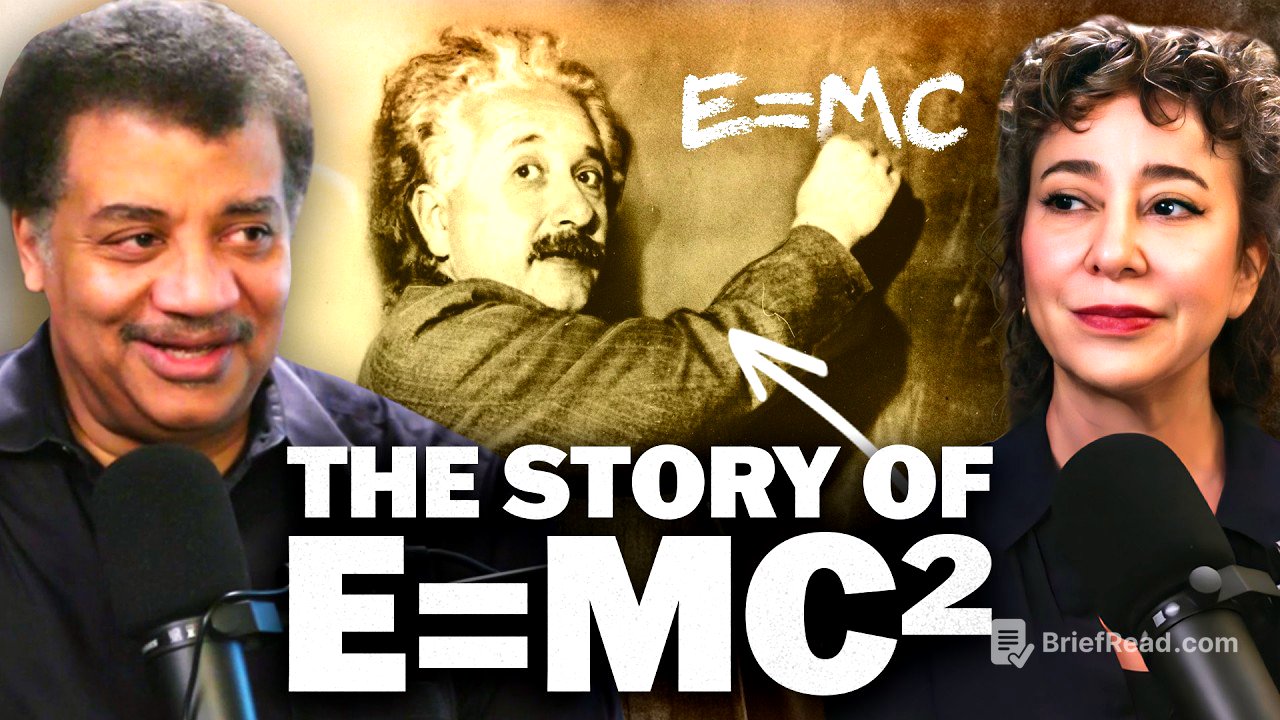TLDR;
This StarTalk episode explores Albert Einstein's groundbreaking work, referring to his major contributions as "Einstein's crumbs." It covers his 1905 papers on the photoelectric effect, special relativity, Brownian motion, and mass-energy equivalence (E=mc²), as well as his later work on general relativity and the cosmological constant. The discussion also touches on black holes, gravitational waves, the quest for a unified field theory, and the potential role of wormholes.
- Einstein's 1905 papers revolutionized physics, but his Nobel Prize was for the photoelectric effect and Brownian motion, not relativity.
- The cosmological constant, initially considered a blunder, later proved to be related to dark energy and the accelerating expansion of the universe.
- Einstein's work continues to inspire and influence modern physics, with ongoing research exploring his ideas on unified field theory and wormholes.
Introduction: Janna Levin [0:00]
The episode starts with Neil deGrasse Tyson introducing the concept of "Einstein's crumbs," referring to the significant but sometimes overlooked implications of Einstein's work. He is joined by co-host Harrison Greenbaum and theoretical cosmologist Janna Levin to discuss Einstein's contributions to physics. Levin's background as a professor of physics and astronomy and her involvement with Pioneer Works, a center for science and art, are highlighted, setting the stage for a discussion that bridges scientific concepts with broader cultural understanding.
Annus Mirabilis: Einstein’s First Four Papers [4:00]
The discussion centers on Einstein's remarkable year of 1905, during which he published four groundbreaking papers. These papers each revolutionized physics and challenged existing paradigms. The panel emphasizes the profound impact of these works, which laid the foundation for many modern scientific advancements.
Photoelectric Effect [5:18]
The photoelectric effect is discussed as the first of Einstein's major contributions in 1905. This paper introduced the idea that light can behave as both a wave and a particle, a concept that was revolutionary at the time. The photoelectric effect demonstrated that when light bombards a surface, it can knock off electrons, behaving more like a particle than a wave.
Special Relativity [6:22]
The theory of special relativity is examined, focusing on Einstein's adherence to the absolute limit of the speed of light. The panel clarifies that the theory could have been called the theory of absolutism because Einstein emphasized the constant nature of the speed of light, regardless of the observer's motion. This concept is illustrated with the example of a train and a ball, contrasting the behavior of light with that of everyday objects.
Brownian Motion [9:12]
Brownian motion is explained as another key contribution from Einstein's 1905 papers. This phenomenon, observed as the random movement of particles in a fluid, provided early evidence for the existence of atoms. Einstein's work related Brownian motion to the quantum nature of matter, demonstrating that air and liquids are composed of individual molecules in constant, random motion.
E=mc^2 [11:35]
The famous equation E=mc² is discussed as the fourth paper from Einstein's "miracle year." This equation, which expresses the equivalence of mass and energy, is recognized as one of the most significant and world-changing results in physics. The panel notes that the implications of this equation far exceeded Einstein's initial motivations for developing it.
Einstein’s One Nobel Prize [12:27]
The conversation addresses the fact that Einstein received only one Nobel Prize, which was awarded for his work on the photoelectric effect and Brownian motion, not for his theories of relativity. The panel explains that the Nobel Prize committee often favored verifiable results, making it difficult for highly theoretical work like relativity to be recognized. This leads to a discussion about the criteria for Nobel Prizes and the challenges faced by theoretical physicists in receiving such awards.
The First Crumb: The Cosmological Constant [15:30]
The cosmological constant is introduced as a significant "crumb" from Einstein's work. Initially added to his equations of general relativity to maintain a static universe, Einstein later called it his "greatest blunder" when the universe was discovered to be expanding. However, the cosmological constant was later found to be related to dark energy, demonstrating that even Einstein's mistakes could lead to important discoveries.
Schwarzschild & Black Holes [26:15]
The discussion shifts to black holes, which were predicted from Einstein's theory of general relativity but not by Einstein himself. Karl Schwarzschild, while serving on the Russian front during World War I, found a solution to Einstein's equations that described the curvature of space-time around a point mass, leading to the concept of black holes. Einstein initially doubted the physical reality of black holes, but they have since become a cornerstone of modern astrophysics.
Making Lasers [31:47]
Einstein's research paper on the stimulated emission of radiation is discussed, which led to the invention of lasers. This paper described how atoms could be stimulated to emit photons, creating a coherent and intense beam of light. The panel emphasizes the extraordinary technological advancement that resulted from this theoretical work, with lasers now being used in a wide range of applications.
Predicting Gravitational Waves [38:14]
The prediction of gravitational waves from general relativity is examined. Einstein predicted that accelerating masses would create ripples in the fabric of space-time, known as gravitational waves. The panel discusses the challenges in detecting these waves and the eventual construction of the LIGO detector, which made the first direct detection of gravitational waves in 2015.
Unified Field Theory & Wormholes [43:18]
Einstein's pursuit of a unified field theory, which aimed to combine all the fundamental forces of nature into a single framework, is explored. The panel notes that while Einstein was unsuccessful in this endeavor, the quest for unification continues to drive modern physics. The discussion also touches on wormholes, which Einstein theorized about, and their potential role in understanding the fundamental nature of gravity and quantum mechanics.
A Cosmic Perspective [48:53]
The episode concludes with a reflection on the profound impact of mathematics in understanding the universe. Neil deGrasse Tyson emphasizes that mathematics, invented by humans, provides a perfect logical framework for manipulating and extending our ideas about the cosmos. He highlights Einstein's ability to attach mathematical models to his physical ideas, leading to countless discoveries and Nobel Prizes for others.









